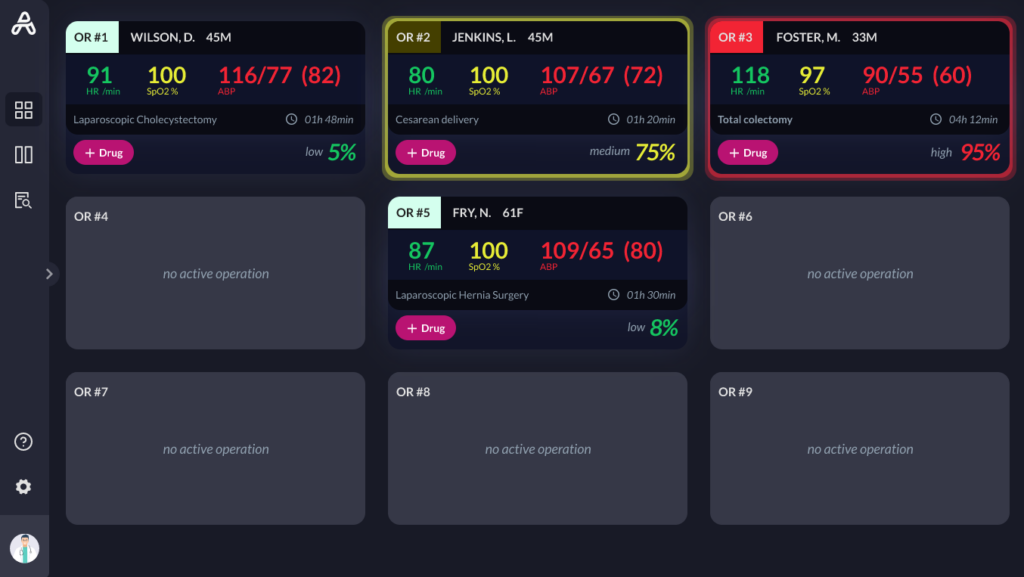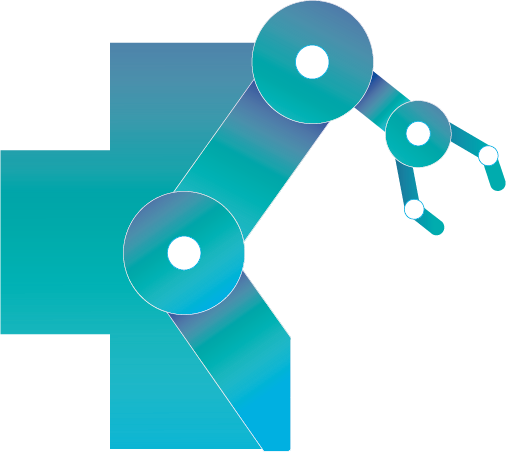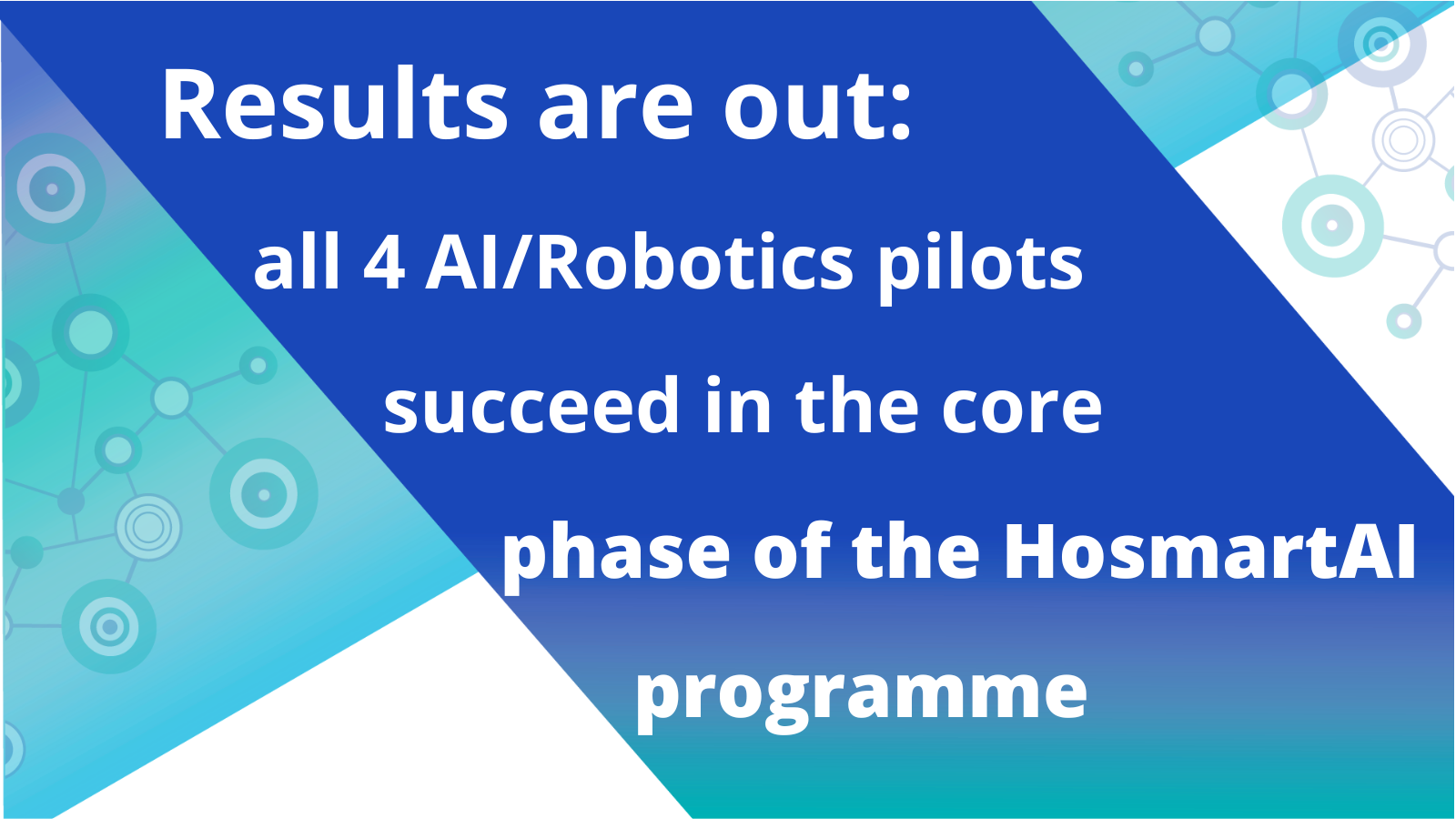Results are out: all 4 AI/Robotics pilots succeed in the core phase of the HosmartAI programme
The work developed during the last 6 months by the 4 AI/Robotics pilots selected via our Open Call 2 was innovative, and it paid off! The results have just come out and all consortia have successfully delivered the work planned for the second phase of the HosmartAI programme: DEVELOP & DEPLOY & OPERATE.
This was the core phase of their pilots, during which the consortia performed the technical developments and deployed them at the healthcare unit to achieve what has been previously proposed.
Main achievements
Here are, in the words of the innovative consortia behind the 4 pilots, the main achievements obtained in this second phase:
Heart bAIt: Remote and unobstructed assessment of vital signs for arrhythmia screening with edge computing
During the DEVELOP & DEPLOY & OPERATE phase we were able to materialize what we had envisioned for this project: a digital solution to assist the screening of Atrial Fibrillation, by using explainable AI and deep learning, using just the patient’s smartphone. Although the tool is fully developed, we are improving it day by day, with the collection of data that allows us to train our AI model and thus make it more seamless every day.
SICS: Smart Intraoperative Clinical Surveillance
During the DEVELOP & DEPLOY & OPERATE phase of the HosmartAI program, significant progress was made in advancing the Smart Intraoperative Clinical Surveillance (SICS) platform. Key activities included the data extraction from the electronic health record (EHR) of University Medical Center of Groningen (UMCG), its harmonisation with an open source database, including intraoperative patient data and patient demographics, the development, refinement and evaluation of advanced AI algorithms for real-time patient data analysis and intraoperative hypotension prediction, the development of the SICS platform, and the refinement of its user interface to meet the dynamic needs of healthcare professionals. The major achievements of this phase were the successful development of the SICS platform, its integration with the HosmartAI FHIR server as well as the integration of the AI hypotension prediction algorithm, demonstrating its capability to enhance perioperative care through AI-driven insights and decision support.

SoftLungX: Software for Diagnosis of Lung Diseases from Chest X-ray Images
In the DEVELOP & DEPLOY & OPERATE phase, the technical provider for the SoftLungX project created the required AI modules: These modules included the lung segmentation and region of interest extraction module, the disease classification module (for 17 different lung diseases and radiological findings); In order to support glass box interpretation of decisions, gradient class activation maps for interpreting the classification decision making process; Docker containers were created for easier system implementation in foreign environments, along with Jupyter notebooks that provide a step-by-step tutorial for the end users. SoftLungX was implemented into the HosmartAI marketplace for dissemination. Additionally, two benchmarking questionnaires were identified for the use in phase 3, during system evaluation in a relevant clinical environment. The system was validated and several iterations of improvements were implemented for each of the aforementioned modules during the final steps of the DEVELOP & DEPLOY & OPERATE phase.
VoiceAI: Prediction of Major Depressive Disorder using Vocal Biomarkers
During Phase 2 (Develop & Deploy & Operate) of the HosmartAI project, VoiceAI consortium conducted the technical development, integration, and deployment of selected HosmartAI components into its VoiceAI services, as well as the collection of participant data. Ensofy team successfully integrated various HosmartAI components in the VoiceAI system, such as HAPI-FHIR platform for secure data storage and access, and JupyterHub for running AI applications. Medic4All Italia team led the project with the collection of patient data, including mental health assessments and voice recordings, in total collecting high-quality data from 50 patients and their physicians.
What does this mean in terms of impact?
The 4 consortia are succeeding in their pilots. Now what do these achievements translate into, when it comes to impact?
Heart bAIt: Remote and unobstructed assessment of vital signs for arrhythmia screening with edge computing
We are now a lot closer to achieving the mission we set ourselves to, which was to contribute to unleashing medical diagnosis from the boundaries of healthcare institutions.
By offering extraction of a range of health parameters, and support for various devices and operating systems, Heart bAIt eliminates the need for wearables or other dedicated hardware used for remote health monitoring, hence facilitating a first line of screening for heart rhythm diseases to large populations.
SICS: Smart Intraoperative Clinical Surveillance
The development of the SICS platform can lead to a transformative impact on perioperative care. By integrating AI-driven analytics and (near) real-time data interpretation, the platform can significantly enhance the decision-making process of healthcare professionals during surgical operations. This can lead to improved patient outcomes, increased efficiency in surgical procedures, and a reduction in the occurrence of intraoperative complications. The platform’s intuitive user interface has been well-received by clinicians, facilitating a more proactive approach to patient care and contributing to the overall improvement of healthcare delivery in surgical settings.
SoftLungX: Software for Diagnosis of Lung Diseases from Chest X-ray Images
SoftLungX, integrated into the HOSMARTAI platform, will bring improvements in the form of improved efficiency and increased accuracy to the diagnostic process concerning patients with lung diseases (i.e. COVID-19, emphysema, hernia, mass, pneumonia etc.). SoftLungX solutions will result in improved resilience of the healthcare system in SoftLungX consortium countries, with the possibility to expand its potential and benefits to healthcare systems in other countries. Through a more accurate and time-saving diagnosis and prediction of different respiratory system diseases, SoftLungX aims to improve the diagnosis precision and outcome, ultimately leading to the improvement of numerous social indicators, including patient quality of life, well-being, level of independence, social inclusion and their productivity. Better outcomes in the field of better symptom management will consequently result in better patient management and healthcare system functioning.
VoiceAI: Prediction of Major Depressive Disorder using Vocal Biomarkers
The collaborative efforts throughout phase 2 resulted in integrated and operational Ensofy services with HosmartAI components and a functional M4A platform for data collection and storage. With patient recruitment and data collection process, the enrolment of 50 patients with balanced demographic and gender distribution was ensured. The VoiceAI was successfully implemented in the tele-consultation setting without any setbacks.
What’s coming next…
The consortia are now entering the final phase of the HosmartAI programme, that will be critical to leverage the results of the 2 previous phases. In the next 4 months, our 4 pilots will focus on the assessment and exploitation of results/achievements.
Here is a sneak peek at the next steps, presented by the 4 winning consortia:
Heart bAIt: Remote and unobstructed assessment of vital signs for arrhythmia screening with edge computing
During the ASSESS phase, we will assess the degree of satisfaction with the Heart bAIt solution and we’ll also work towards having a peer-reviewed publication describing this pilot experiment, explanatory communications at specialty conferences (both tech- and healthcare-related), social media dissemination actions, participation at medical fairs to exhibit the final solution and do market prospects.
SICS: Smart Intraoperative Clinical Surveillance
In the upcoming ASSESS phase, the focus will be on the clinical validation of the SICS algorithms and platform. This will involve comprehensive evaluations in real-world scenarios using patient data to test the AI algorithms effectiveness and reliability. Feedback from clinical end-users will be crucial in this phase, as it will inform further refinements to both the AI algorithms and the user interface. The goal is to ensure that the SICS platform not only aligns with clinical needs, but also surpasses current standards in patient monitoring and perioperative care.
SoftLungX: Software for Diagnosis of Lung Diseases from Chest X-ray Images
In the ASSESS phase, the SoftLungX consortium will implement the created system in the University Clinical Center Kragujevac, where it will be tested with real patient lung X-ray data and compared to the results achieved through standard clinical approaches. During testing, feedback will be given by medical professionals about the potential errors the system makes, but also about the system ease of use. The medical professional part of the consortium will be tasked with testing and interpreting suggestions, while the technical provider part of the consortium will be tasked with their implementation. The outcome of the ASSESS phase will be a disease classification system with similar architecture, improved for better tackling scenarios in clinical environment.
VoiceAI: Prediction of Major Depressive Disorder using Vocal Biomarkers
During the upcoming Phase 3 (ASSESS), the primary focus will be on analysing the data collected in Phase 2 and evaluating the outcomes of the VoiceAI against the KPIs, with a particular emphasis on assessing the credibility, utility, and value of VoiceAI to involved stakeholders. The overarching goal is to provide a thorough and insightful assessment of the obtained results and achievements, informing stakeholders about the efficacy and potential of VoiceAI in the given context.







